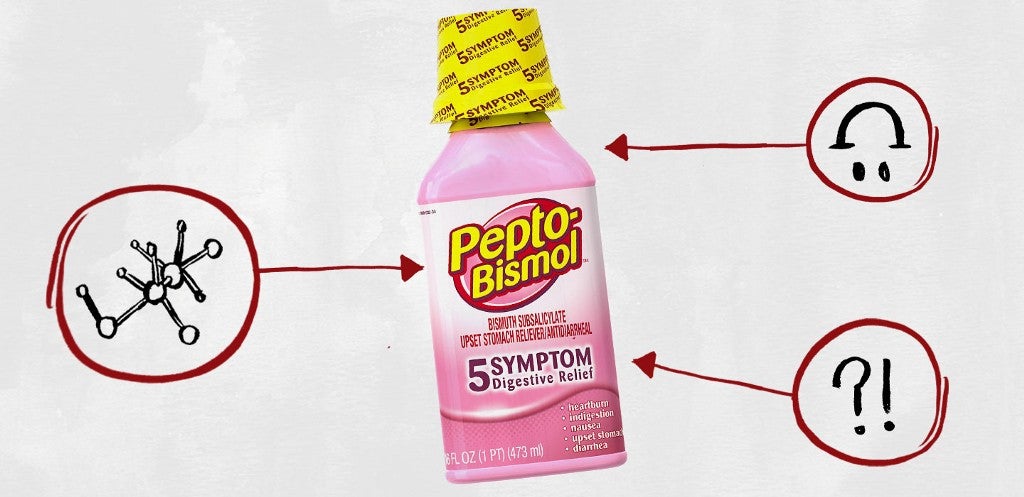We’re often told that you should never eat anything if you don’t recognize everything on the ingredients list. But since most of us have no idea what xanthan gum or potassium benzoate are — or more importantly, what they’re doing to our bodies — we’re decoding the ingredients in the many things Americans put in (and on) themselves with the help of an expert. This edition: Pepto-Bismol, which is made from 12 separate ingredients, that we’ve broken down in the exact order they appear on the stomach-soother’s website.
The Ingredients
1) Bismuth Subsalicylate: Bismuth subsalicylate is the primary active ingredient in Pepto-Bismol, since its antacid properties help to decrease heartburn, upset stomach and nausea by neutralizing stomach acids. Studies show that consuming bismuth subsalicylate every day for more than six weeks may lead to accumulation of salicylate, and eventually salicylate poisoning, which can cause ringing in the ears, abdominal pain and an increased breathing rate. So don’t get in the habit of pounding this stuff on the daily.
2) Benzoic Acid: “Benzoic acid most commonly functions as a preservative in foods and cosmetics,” explains Dagan Xavier, ingredient expert and co-founder of Label Insight. “It can also be used to add fragrance to a product.” Various studies found that benzoic acid is poisonous in large doses, but it would be near impossible to consume enough of the stuff in foods (or medications) for it to be lethal.
3) Flavor: This is what gives Pepto-Bismol that classic cherry flavor.
4) Magnesium Aluminum Silicate: “The primary function of magnesium aluminum silicate is as a thickening agent within cosmetics and personal care products,” Xavier says. It’s probably what gives Pepto-Bismol that coat-your-entire-mouth texture. Unfortunately, it’s an ingredient to watch out for: “There is growing evidence for a link between Al [aluminum] and AD [alzheimer’s disease],” a 2011 study concludes. And by consuming magnesium aluminum silicate, you’re, of course, consuming exactly that — aluminum.
5) Methylcellulose: “Methylcellulose is a thickener and emulsifier,” Xavier explains. “It can have a laxative effect, and it’s sold under several brand names to treat constipation.” It does so by absorbing water and increasing in bulk as it passes through your bowels, resulting in a more regular release.
6 & 7) Red 22 and Red 28: Artificial colors are created in a lab by chemists. Unfortunately, they’re known to be cancerous: “Because color molecules are a similar shape to some of our DNA structures, they’re able to make their way in there and cause issues,” explains physician and biochemist Cate Shanahan, author of Deep Nutrition: Why Your Genes Need Traditional Food. “That said, I’ve always been of the opinion that studies claiming artificial colors can cause cancer are irrelevant because [in the studies] they use really high amounts of the artificial colors — like, a million times more than you’d ever get [in your] food [throughout your lifetime].” So the average person’s liver should be able to break down whatever minuscule amount of artificial coloring we consume with food.
8) Saccharin Sodium: As we learned in our exploration of all 10 ingredients in strawberry-flavored lube, saccharin sodium is the solid form of an artificial sweetener called saccharin. During the 1970s, controversial studies performed on rodents found the ingredient to be carcinogenic, though subsequent studies on both people and primates found that saccharin was indeed safe for human consumption. In particular, one of those studies, published in the Journal for the National Cancer Institute in 1998, found that primates exposed to saccharin on a daily basis from birth showed no adverse effects.
9) Salicylic Acid: Salicylic acid is responsible for the anti-inflammatory effect of aspirin, which is why it’s found in Pepto-Bismol: To help soothe your stomach. It’s also more commonly used to treat acne by dissolving the type of skin debris that clogs pores.
10) Sodium Salicylate: “Sodium salicylate has anti-inflammatory properties that make it a weaker alternative to aspirin in relieving pain and reducing fever,” Xavier explains. In this case, it’s probably added to provide a bit of extra relief without overdoing it: Remember, consuming too much salicylate can lead to salicylate poisoning.
11) Sorbic Acid: A preservative used for its antimicrobial properties, sorbic acid is on the FDA’s list of “generally recognized as safe,” or GRAS, substances.
12) Water: This is simply used to give Pepto-Bismol a liquid texture.
The Takeaway
The only real worrisome ingredient in Pepto-Bismol is magnesium aluminum silicate, and that won’t do you any harm if you consume it like a normal person (like after the occasional gluttonous meal, and not every day). It does the job it’s meant to do, and nothing more. For that, and for making the rest of the Day After Thanksgiving dinner a bit more bearable, Pepto-Bismol — much like Alka-Seltzer — wins our hearts (and our stomachs).

